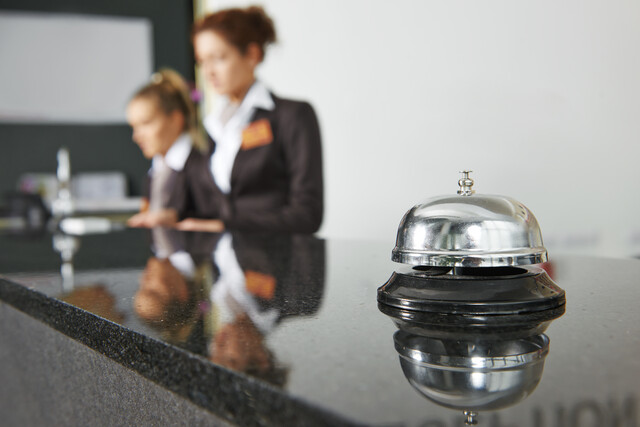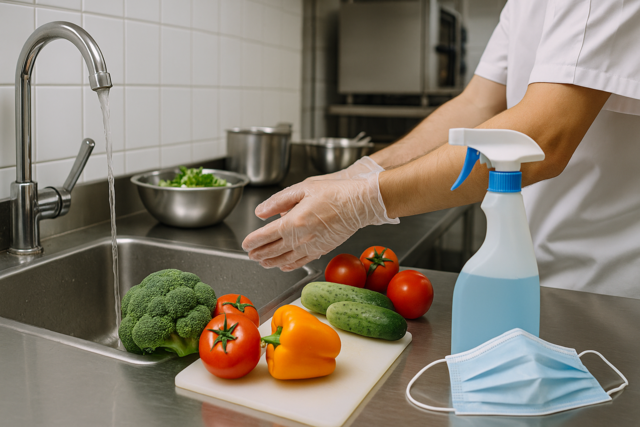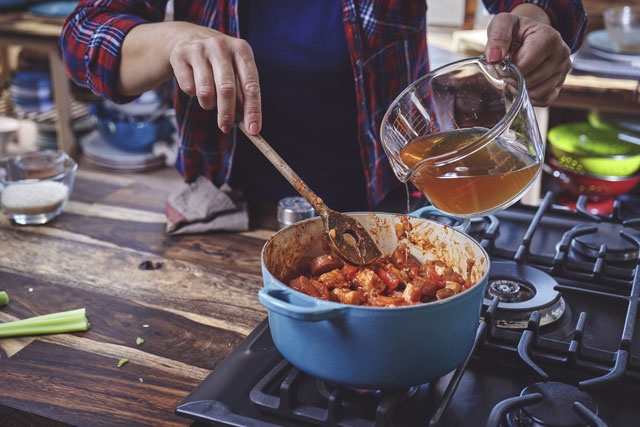Pots, pans, and utensils
Take all the pots, pans, cutting boards, and knives to the dishwasher. Once these items are clean, return them to their proper places.
Food prep areas
At the end of every shift, clean and sanitize all food prep surfaces. Clean and polish all stainless steel surfaces.
Hot line After each shift, clean and sanitize all the stove surfaces. Clean out the oven, and make sure that all the burners and elements are turned off.
Walls If you don't pay attention to your walls, they will quickly become disgusting. Walls are a natural place for condensation and grease to accumulate, causing a fantastic breeding ground for bacteria and a potential fire hazard. Of course, you can't scrub down walls while food prep is going on, but once the shift is over, you can thoroughly swab down the walls. Swabbing the walls will make it possible for you to get the facility really clean, instead of just moving dirt from one place to another.
Wallpaper is a bad idea anywhere in a restaurant. The seams provide an attractive hiding space for dirt and pests. But if you do have wallpaper anywhere, make sure the seams are always well-maintained and securely attached to the wall.
Floors Sweep and mop floors after every shift. As you are cleaning, you should be able to reach under every table, island, and shelf to remove particles. When you are mopping, if you see anything blocking your access to the floor (boxes of food, cases of wine or beer), make sure you point it out to a manager who can help you relocate it to an appropriate place.
Range Hoods The majority of fires in professional kitchens start with an unsafe ventilation system. The purpose of the range hood is to suck up air from the cooking surface. Along with the air comes all the grease. Much of this grease clings to the hood, creating a situation where a single flare or spark from the stove below has the potential to create a potentially disastrous fire. In addition to lowering the risk of fire, a clean range hood also filters out smoke, grease, and heat more effectively, resulting in a better environment for your workers and customers.
How often you need to clean your range hood will depend on a few factors, like how high-volume your facility is and how much greasy food you serve. At a minimum, you should visually inspect the hood at the end of every shift to make sure it appears in good working order.
The range hood deep-clean should happen about every three to six months -- or more often in a fast food restaurant. This is one job that is best out-sourced to a professional cleaning company that specializes in commercial range hoods. It is possible to do it in-house, but it is a dirty and time-consuming job. Professionals can do it very efficiently, with less risk of cross-contamination.
Refrigerators and Freezers Walk-in units should be swept and mopped every day. Thermometers should be checked and calibrated regularly. At the end of each day, check dates on food items and make sure they are still within their safe range of use. Rotate older foods so they may be used in a first-in, first-out (FIFO) order.
Sinks At the end of each shift, take a look at the sinks. Hand-washing sinks should not have any debris or food trash in them. If they do, remove it promptly. Mop water should never be poured down a hand-washing or dish-washing sink. Wipe down the surfaces of the sinks and use a sanitizer to kill surface germs. The dishwasher is responsible for cleaning and sanitizing the dishwashing sink. Always check and be sure the plumbing is in good working order -- slow drains provide a breeding ground for germs, and leaky plumbing -- either at the faucet or the drain -- is a health and safety hazard.
Dining Room The dining room requires just as much attention as the kitchen. Many restaurants prefer to hire a professional cleaning company to thoroughly deep-clean the dining area (not the kitchen) after closing each day.
Floors The floors in the dining room must be swept, mopped, or vacuumed at the end of each shift. Any carpeting should be steam cleaned at least once a year.
Walls When your customers are sitting around waiting for their food, they may be engaged in an exciting conversation with their companions, or they may be very bored, with nothing to do but stare at the walls around them. At this point, if they see a trail of ants crawling up the peeling wallpaper, they are likely to leave immediately and tell 15 of their friends what they saw. It is essential to keep dining room walls clean. Wipe them down at the end of each shift, making sure to remove any traces of food, spills or cobwebs. Wallpaper and paint should also be inspected regularly. Keep an eye out for peeling paper or cracking paint.
Tables Tables should be sanitized after each party sits at them. At the end of the night, strip down and replace all table linens and sanitize any salt and pepper shakers or other dispensers that sit at the table throughout the day.
Furniture Sanitize chairs between parties. At the end of the shift, dust all furniture, windowsills, and any artwork.
Bathrooms The bathrooms have to be cleaned at least at the end of each shift, and more often if it is a high-volume facility. Sweep and mop the floors, sanitize all sinks, and remove all trash. Make sure all stalls are stocked with toilet paper, and there are plenty of paper towels and other supplies.
Outside Don't forget the outside: Sweep the sidewalks, empty exterior trash bins, and look for trash in the parking lot. Keep trash in the dumpster, well away from the kitchen area. Trash cans used inside must be sanitized and replaced before they become smelly, dirty, or full of build-up.
Pest control No matter how well you follow the rules, and how clean you keep your restaurant, eventually some sort of critter will find its way inside. Ants, roaches, mice, rats, and other vermin are not only disgusting, they also carry diseases. Nothing can ruin your restaurant's reputation (or get it closed down for a health violation) faster than pests. Keeping your restaurant clean, with dry goods tightly sealed in durable plastic containers, and all supplies at least six inches off the floor will help. Making sure to remove trash in a timely manner, and scheduling dumpster pickups frequently will also help. But whenever you see any evidence of pest infestation, it is important to act quickly.
Have a pest management plan in place before you ever see a pest. To formulate a plan, work closely with your trusted pest control professional. Then, do your best to keep the vermin out. It is far easier to deny entry to pests than it is to get rid of them once they make themselves comfortable and start to multiply.
Walk-in pests In the summer, flies wing in through open doors and windows, ants march through cracks in foundations, and mice crawl through tiny holes around plumbing. They are all looking for the same thing: a source of food and water and a safe place to nest. If you provide them these things, they will never leave your restaurant. To keep them from coming in, make sure you follow the instructions about food storage described above, so that they cannot easily access and contaminate your food stores. Also, be sure all windows have screens, and that all doors are self-closing. Doors should also have sweeps on the bottom and air curtains on the top.
Seal all visible cracks in walls and spaces where large equipment is attached to the floor. Pay particular attention to gaps around piping. Also make sure that floor drains have grates on top and that vents and pipes on the roof are properly screened.
Keep trash only in appropriate areas. Never let rotting food accumulate inside, and make sure all trash bins inside and out are emptied and sanitized on a regular basis.
Pest reception
Roaches, moths, and other vermin also travel along with the food you purchase. For this reason, it is very important to check all foods you receive before allowing them to be unpacked into your storage area. Look for signs of infestation, like nibbled packages, droppings, hairs, and shreds of paper that resemble a nest. If you see anything unusual, question it immediately.
Responding to pests It's a good idea to keep glue traps under shelves and reach-ins. Check the traps often to see what kinds of pests have wandered across. Always keep an eye out for any signs of infestation, like egg shells, stray hairs (there is no acceptable reason to have animal hairs in your kitchen, so seeing any of these should be an immediate call to action. Droppings and urine stains are other signals to act immediately.
Any feces or egg shells must be vacuumed up and the area must be sanitized. If there is any sign that vermin have infested your food stores, the affected foods will have to be thrown out immediately.
Pest control professionals Pest control professionals can help you create a clean and pest-free environment, but even the best chemicals can't make up for a dirty kitchen. Follow your state and local requirements for kitchen sanitation, and then select a qualified pest control professional. Be careful when selecting a company for this job: it is important that your vendor have lots of previous experience with commercial kitchens. Ask for a list of references from other restaurants, and take the time to call and check them. Be sure to ask what kinds of materials they will be using in your facility, and make sure they are safe for food-prep areas. Also, be sure to discuss how you will need to prepare for the treatment, and what special steps you will need to take after it is complete.
Make sure your pro is interested in helping you maintain a healthy and pest-free environment. If he is, he will help provide tips for pest control between his visits. Find a range of providers (at least three), and make sure you find someone who is experienced and well-qualified, not just the least expensive provider.
























